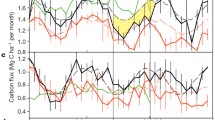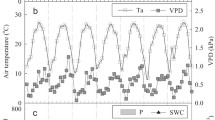Abstract
In 2001–03, continuous eddy covariance measurements of carbon dioxide (CO2) flux were made above mature boreal aspen, black spruce, and jack pine forests in Saskatchewan, Canada, prior to and during a 3−year drought. During the 1st drought year, ecosystem respiration (R) was reduced at the aspen site due to the drying of surface soil layers. Gross ecosystem photosynthesis (GEP) increased as a result of a warm spring and a slow decrease of deep soil moisture. These conditions resulted in the highest annual net ecosystem productivity (NEP) in the 9 years of flux measurements at this site. During 2002 and 2003, a reduction of 6% and 34% in NEP, respectively, compared to 2000 was observed as the result of reductions in both R and GEP, indicating a conservative response to the drought. Although the drought affected most of western Canada, there was considerable spatial variability in summer rainfall over the 100−km extent of the study area; summer rainfalls in 2001 and 2002 at the two conifer sites minimized the impact of the drought. In 2003, however, precipitation was similarly low at all three sites. Due to low topographic position and consequent poor drainage at the black spruce site and the coarse soil with low water-holding capacity at the jack pine site almost no reduction in R, GEP, and NEP was observed at these two sites. This study shows that the impact of drought on carbon sequestration by boreal forest ecosystems strongly depends on rainfall distribution, soil characteristics, topography, and the presence of vegetation that is well adapted to these conditions.










Similar content being viewed by others
References
Albritton DL, Meira Filho LG, Cubasch U, Dai X, Ding Y, Griggs DJ, Hewitson B, and others. 2001. Technical summary of the Working Group I report: climate change 2001. Technical Report 21–83. Geneva: The Scientific Basis IPCC, WMO
Arain A, Black TA, Barr AG, Jarvis PG, Massheder JM, Verseghy DL, Nesic Z. 2002. Effects of seasonal and interannual climate variability on net ecosystem productivity of boreal deciduous and conifer forests. Can J For Res 32:878–91
Aubinet M, Grelle A, Ibrom A, Rannik U, Moncrieff J, Foken T, Kowalski AS, et al. 2000. Estimates of the annual net carbon and water exchange of forests: the EUROFLUX methodology. Adva Ecol Res 30:113–75
Baldocchi DD. 1997. Measuring and modeling carbon dioxide and water vapour exchange over a temperate broad-leaved forest during the 1995 summer drought. Plant Cell Environ 20:1108–22
Baldocchi DD, Vogel CA. 1997. Seasonal variation of energy and water vapor exchange rates above and below a boreal jack pine forest canopy. J Geophys Res 102:28939–51
Baldocchi DD, Vogel CA, Hall B. 1997. Seasonal variation of carbon dioxide exchange rates above and below a boreal jack pine forest canopy. Agric For Meteorol 83:147–70
Baldocchi DD, Black TA, Curtis PS, Falge E, Fuentes JD, Granier A, Gu L, et al. 2005. Predicting the onset of net carbon uptake deciduous forests with soil temperature and climate data: a synthesis of FLUXNET data. Int J Biometeorol 49:377–87
Barr AG, Black TA, Hogg EH, Kljun N, Morgenstern K, Nesic Z. 2004. Inter-annual variability in the leaf area index of a boreal aspen–hazelnut forest in relation to net ecosystem production. Agric For Meteorol 126:237–55
Barr AG, Black TA, Theede A, Griffis TJ, Kljun N, Morgenstern K, Nesic Z. 2005. Climatic controls on the carbon and water balances of a boreal aspen forest, 1994–2003. Global Change Biol. Forthcoming
Bernier PY, Bartlett P, Black TA, Barr AG, Kljun N, McCaughey JH. 2006. Drought constraints on transpiration and canopy conductance in mature aspen and jack pine stands. Agric For Meteorolo. Forthcoming
Black TA, den Hartog G, Neumann H, Blanken P, Yang P, Russell C, Nesic Z, et al. 1996. Annual cycles of water vapour and carbon dioxide fluxes in and above boreal aspen forest. Global Change Biol 2:219–29
Black TA, Chen WJ, Barr AG, Arain MA, Chen Z, Nesic Z, Hogg EH, et al. 2000. Increased carbon sequestration by a boreal deciduous forest in years with a warm spring. Geophys Res Lett 27:1271–4
Blanken PD, Black TA, Yang PC, Neumann HH, Nesic Z, Staebler R, den Hartog G, et al. 1997. Energy balance and canopy conductance of a boreal aspen forest: partitioning overstory and understory components. J Geophy Res 102:28915–28
Borken W, Xu Y-J, Brumme R, Lamersdorf N. 1999. A climate change scenario for carbon dioxide and dissolved organic carbon fluxes from a temperate forest soil: drought and rewetting effects. Soil Sci Soc Am J 63:1848–55
Borken W, Savage K, Davidson EA, Trumbore SE. 2005. Effects of experimental drought on soil respiration and radiocarbon efflux from a temperate forest soil. Global Change Biol. Forthcoming
Burns RM, Honkala BH, Eds. 1990. Silvics of North America: 1. conifers; 2. hardwoods. Agriculture Handbook 654. Washington (DC): US Department of Agriculture, Forest Service. 877 p
Campbell GS, Norman JM. 1998. An introduction to environmental physics. New York: Springer. p 286
Drewitt GB, Black TA, Nesic Z, Humphreys ER, Jork EM, Swason R, Ethier GJ, et al. 2002. Measuring forest floor CO2 fluxes in a Douglas-fir forest. Agric For Meteorol 110:299–317
Foti S, Cosentino L, Patan C, Copani V, Sanzone E. 2003. Plant indicators of available soil water in the perennial herbaceous crop Miscanthus × giganteus Greef et Deu. Agronomie 23:29–36
Gaumont-Guay D. 2005. Soil respiration in deciduous and coniferous boreal forest stands [dissertation]. Vancouver: University of British Columbia
Gower ST, Vogel JG, Norman JM, Kucharik CJ, Steele SJ Stow TK. 1997. Carbon distribution and aboveground net primary production in aspen, jack pine, and black spruce stands in Saskatchewan and Manitoba, Canada, J Geophys Res 102:29029–41
Griffis TJ, Black TA, Morgenstern K, Barr AG, Nesic Z, Drewitt GB, Gaumont-Guay D, et al. 2003. Ecophysiological controls on the carbon balances of three southern boreal forests. Agric For Meteorol 125:207–23
Griffis TJ, Black TA, Gaumont-Guay D, Drewitt GB, Nesic Z, Barr AG, Morgenstern K, et al. 2004. Seasonal variation and partitioning of ecosystem respiration in a southern boreal aspen forest. Agric For Meteorol 117:53–71
Hogg EH. 1997. Temporal scaling of moisture and the forest–grassland boundary in western Canada. Agric For Meteorol 84:115–22
Hollinger DY, Kelliher FM, Schulze E-D, Bauer G, Arneth A, Byers J-N, Hunt J-E, et al. 1998. Forest–atmosphere carbon dioxide exchange in eastern Siberia. Agric For Meteorol 90:291–306
Jarvis PG, Massheder JM, Hale SE, Moncrieff JB, Rayment M, Scott SL. 1997. Seasonal variation of carbon dioxide, water vapor, and energy exchanges of a boreal black spruce forest. J Geophys Res 102:28953–66
Keeling CD, Chin JFS, Whorf TP. 1996. Increased activity of northern vegetation inferred from atmospheric CO2 Measurements. Nature 382:146–9
Kimbal JS, Keyser AR, Running SW, Saatchi SS. 2000. Regional assessment of boreal forest productivity using an ecological process model and remote sensing parameter maps. Tree Physiol 20:761–75
Kljun N, Rotach MW, Calanca P. 2004. A simple parameterisation for flux footprint predictions. Boundary-Layer Meteorol 112:503–23
Landsberg JJ, Gower ST, 1997. Applications of physiological ecology to forest management. San Diego: Academic Press
Lindroth A, Grelle A, Moren AS. 1998. Long-term measurements of boreal forest carbon balance reveal large temperature sensitivity. Global Change Biol 4:443–50
Lotsch A, Friedl MA, Anderson B, Tucker CJ. 2005. Response of terrestrial ecosystems to recent Northern Hemispheric drought. Geophys Res Lett 32:L06705. doi: 10.1029/2004GL022043
McClone MS. 1996. When history matters: scale, time, climate and tree diversity. Global Ecol Biogeogr Lett 5:309–14
Milyukova IM, Kolle O, Varlagin AV, Vygodskaya NN, Schulze ED, Lloyd J. 2002. Carbon balance of a southern taiga spruce stand in European Russia. Tellus [B] 54:429–42
Morgenstern K, Black TA, Humphreys ER, Griffis TJ, Drewitt GB, Cai T, Nesic Z, et al. 2004. Sensitivity and uncertainty of the carbon balance of a Pacific Northwest Douglas-fir forest during an El Niña cycle. Agric For Meteorol 123:201–19
Reichstein M, Tenhunen JD, Roupsard O, Ourcival J-M, Rambal S, Miglietta F, Peressotti A, et al. 2002. Severe drought effects on ecosystem CO2 and H2O fluxes at three Mediterranean evergreen sites: revision of current hypotheses? Global Change Biol 8:999–1017
Ryan MG, Lavigne MB, Gower ST. 1997. Annual carbon cost of Autotrophic respiration in boreal forest ecosystems in relation to species and climate. J Geophys Res 102:28871–83
Sellers PJ, Hall FG, Kelly RD, Black TA, Baldocchi D, Berry J, Ryan M, et al. 1997. BOREAS in 1997: experiment overview, scientific results, and future directions. J Geophys Res 102:28731–69
Tanner CB, Thurtell GW. 1969. Anemoclinometer measurements of Reynolds stress and heat transport in the atmospheric boundary layer. Research and Development Technical Report ECOM66-G22F. Madison (WI): University of Wisconsin
Webb EK, Pearman GI, Leuning R. 1980. Correction of Flux measurements for density due to heat and water vapour transfer. Q J R Meteorol Soc 106:85–100
Yang PC, Black TA, Neumann HH, Blanken PD. 1999. Spatial and temporal variability of CO2 concentration and flux in a boreal aspen forest. J Geophys Res—Atmos 104:27653–61
AcknowledgEments
Financial support was provided by the Climate Research Branch of the Meteorological Service of Canada, the Canadian Forest Service, Parks Canada, the Action Plan 2000 on Climate Change, the Program of Energy Research and Development, the Climate Change Action Fund, through funding for the Fluxnet Canada Research Network (Natural Sciences and Engineering Research Council of Canada, BioCap Canada, the Canadian Foundation for Climate and Atmospheric Science), by the Swiss National Science Foundation, and the Swiss Federal Institute of Technology.We sincerely thank Barry Goodison and Bob Stewart for their support and encouragement. We gratefully acknowledge the assistance, support, and suggestions of Dell Bayne, Bruce Cole, Joe Eley, Steve Enns, Charmaine Hrynkiw, Rachhpal Jassal, Rick Ketler, Shawn O’Neil, Andrew Sauter, Dave Wieder, and two anonymous reviewers.
Author information
Authors and Affiliations
Corresponding author
Rights and permissions
About this article
Cite this article
Kljun, N., Black, T.A., Griffis, T.J. et al. Response of Net Ecosystem Productivity of Three Boreal Forest Stands to Drought. Ecosystems 9, 1128–1144 (2006). https://doi.org/10.1007/s10021-005-0082-x
Received:
Accepted:
Published:
Issue Date:
DOI: https://doi.org/10.1007/s10021-005-0082-x




